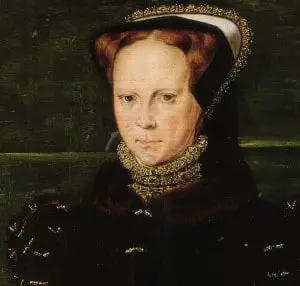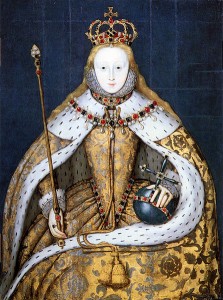 On 17th November 1558, Henry VIII’s eldest child, Queen Mary I, died. She was just forty-two years-old.
On 17th November 1558, Henry VIII’s eldest child, Queen Mary I, died. She was just forty-two years-old.
After Easter 1558, Mary I made her will because she believed that she was pregnant. The birth should have been imminent because Philip departed in July 1557, yet there is no mention in the records of preparations being made such as nursery staff being appointed, remarks on her changing body shape, preparations for confinement etc. The pregnancy was all in Mary’s mind.
Mary’s health began to decline from that point on, although nobody seems to have been unduly worried at the time. In August 1558, Mary contracted a fever, and although she was able to fight that off, she was reported to be suffering from a “dropsy” at the end of September. At the end of October she made an addition to her will, and although she did not name Elizabeth, her half-sister, she did confirm that the throne would go to the next lawful heir, and that was Elizabeth. The Duke of Feria arrived at the English court on the 9th November and reported to his master, Mary’s husband Philip II of Spain, on the 14th November:
“there is… no hope of her life, but on the contrary each hour I think that they will come to inform me of her death, so rapidly does her condition deteriorate from one day to the next.”1
In her last days, Mary spoke of visions of angels, and of how the word “Calais” would be found written across her heart after her death. She received the ‘viaticum’, the special holy communion for the dying, on the 17th November, and was able to make the appropriate responses before she lapsed into unconsciousness, never to wake again. The exact time of her death is not recorded as it was not noticed, and she slipped peacefully away.
On Mary’s death, her twenty-five year-old half-sister, Elizabeth, became Queen. Elizabeth was the daughter of Henry VIII and Anne Boleyn. Elizabeth I was proclaimed Queen at around noon at Whitehall by the Houses of Lords and Commons who had been in session that morning. In the meantime, Sir Nicholas Throckmorton rode from London to Hatfield, carrying Mary’s ring to Elizabeth as proof that Mary was dead. Members of Mary’s council also made their way to Hatfield to see Elizabeth.
 According to tradition, Elizabeth was sitting under an old oak tree in the parkland around the palace of Hatfield, reading a book, when lords of the council disturbed her to give her the news. Overcome with emotion, she sank to her knees and said in Latin “This is the Lord’s doing: it is marvellous in our eyes”, from Psalm 118. Another story, told by Elizabeth’s godson, Sir John Harington, has Elizabeth making the following speech:
According to tradition, Elizabeth was sitting under an old oak tree in the parkland around the palace of Hatfield, reading a book, when lords of the council disturbed her to give her the news. Overcome with emotion, she sank to her knees and said in Latin “This is the Lord’s doing: it is marvellous in our eyes”, from Psalm 118. Another story, told by Elizabeth’s godson, Sir John Harington, has Elizabeth making the following speech:
“My lords, the law of nature moveth me to sorrow for my sister; the burden that is fallen upon me maketh me amazed; and yet, considering I am God’s creature, ordained to obey His appointment, I will thereto yield, desiring from the bottom of my heart that I may have assistance of His grace to be the minister of His heavenly will in this office now committed to me. And as I am but one body naturally considered, though by His permission a body politic to govern, so I shall desire you all, my lords (chiefly you of the nobility, everyone in his degree and power), to be assistant to me, that I with my ruling and you with your service may make a good account to almighty God and leave some comfort to our posterity in earth. I mean to direct all my actions by good advice and counsel. And therefore, considering that divers of you be of the ancient nobility, having your beginnings and estates of my progenitors, kings of this realm, and thereby ought in honour to have the more natural care for maintaining of my estate and this commonwealth; some others have been of long experience in governance and enabled by my father of noble memory, my brother, and my late sister to bear office; the rest of you being upon special trust lately called to her service only and trust, for your service considered and rewarded; my meaning is to require of you all nothing more but faithful hearts in such service as from time to time shall be in your powers towards the preservation of me and this commonwealth. And for council and advice I shall accept you of my nobility, and such others of you the rest as in consultation I shall think meet and shortly appoint, to the which also, with their advice, I will join to their aid, and for ease of their burden, others meet for my service. And they which I shall not appoint, let them not think the same for any disability in them, but for that I do consider a multitude doth make rather discord and confusion than good counsel. And of my goodwill you shall not doubt, using yourselves as appertaineth to good and loving subjects.”2
Extract from On This Day in Tudor History by Claire Ridgway.
Also on this day in history…

- 1558 – Death of Cardinal Reginald Pole, Mary I’s Archbishop of Canterbury, at Lambeth Palace in London. He had been ill since September 1558 and died after hearing news of Mary I’s death. He lay in state at the palace for forty days before being buried at Becket’s Corona in Canterbury Cathedral.
Notes and Sources
- Quoted in Tudor Queens of England, D. M. Loades (2009), p206
- Nugae antiquae : being a miscellaneous collection of original papers, in prose and verse; written during the reigns of Henry VIII. Edward VI. Queen Mary, Elizabeth, and King James. Selected from authentic remains by the late Henry Harington, and newly arranged, with illustrative notes, Sir John Harington, Henry Harington and Thomas Park (1804), p66-68